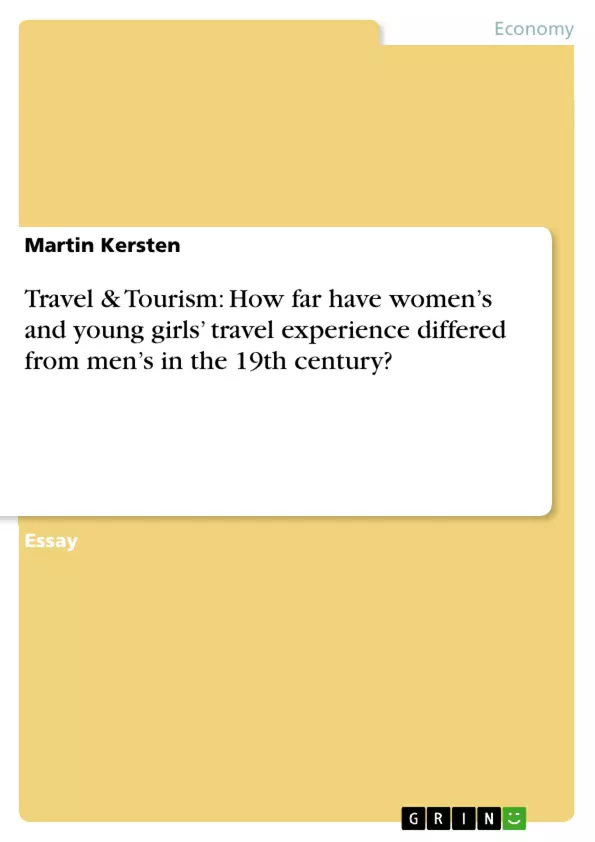Prior the middle of the twentieth century, women were discouraged for travelling at all, unless they were planning a journey through safe, civilised territory. Even then they were typically chaperoned by male relatives. Clothing gear for travel related activities like bicycling, horseback riding, and mountain climbing were originally designed only for males. This essay will try to deduce what kinds of difficulties women had to confront and how British women’s and girl’s travel experiences differed from the experiences of British men in the 19th century. To certify my thought I will analyse some letters and books written by travelling women.
Inhaltsverzeichnis (Table of Contents)
- Introduction
- Travel Literature and the Absence of Women
- Reasons Why Women Traveled
- The Emotional Experience of Women Travellers
- Travel in Disguise
- Gender, Loyalty, and Colonialism
- Women and Science
- Women's Travels and Society's Boundaries
- The Feeling of Freedom
- Accommodation and Social Class
Zielsetzung und Themenschwerpunkte (Objectives and Key Themes)
This essay examines the differences in travel experiences between British women and men during the 19th century. The author explores the challenges faced by women travellers, including social expectations, safety concerns, and limited opportunities for independent travel.
- Gendered travel experiences in 19th century Britain
- Social limitations and expectations imposed on women travellers
- The impact of colonialism on women's travel writing
- The role of class and privilege in shaping travel opportunities
- Women's growing sense of freedom and emancipation through travel
Zusammenfassung der Kapitel (Chapter Summaries)
- The introduction sets the context for the essay by highlighting the historical limitations placed on women's travel and the relative lack of female voices in travel literature.
- Chapter two explores the reasons behind the limited representation of women in travel writing, focusing on societal constraints and the challenges faced by women who dared to venture beyond their homes.
- Chapter three delves into the motivations behind women's travel, examining different reasons such as escaping domesticity, seeking adventure, or pursuing missionary work.
- Chapter four focuses on the emotional experiences of women travellers, highlighting the cultural shock and anxieties they encountered while abroad, particularly in comparison to their male counterparts.
- Chapter five examines the lengths women went to to travel freely, including disguising themselves as men to avoid harassment and societal restrictions. This chapter showcases examples like Sarah Hobson and Isabelle Eberhardt.
- Chapter six analyzes the interplay between gender, loyalty, and colonialism in travel writing. It explores how women travellers often formed bonds with other women and the complexities of adopting the "imperialist voice" in their narratives.
- Chapter seven discusses the presence of women in scientific travel, challenging the stereotype of science as a male domain. It presents examples like Florence Baker and Mary Wollstonecraft.
- Chapter eight explores the social restrictions placed upon women, particularly regarding independent travel and the perception of "ladylike" behavior. The author examines the role of Thomas Cook in facilitating women's travel through organized tours.
- Chapter nine focuses on the sense of freedom and emancipation experienced by women travellers, highlighting how their journeys allowed them to break free from societal norms and realize their potential. The chapter emphasizes the growing independence and confidence women gained through travel.
- Chapter ten discusses the impact of social class on women's travel experiences, highlighting the difference between the opportunities available to privileged women and those faced by lower-class women, who might have travelled for work during the Industrial Revolution.
- The concluding chapter, not included in this preview, likely synthesizes the key arguments and provides a broader analysis of the evolution of women's travel experiences in 19th century Britain.
Schlüsselwörter (Keywords)
This essay focuses on the themes of gender, travel, and societal expectations in 19th century Britain. Key concepts include women's travel experiences, colonial influence, class divisions, and the growing movement towards women's emancipation. The author utilizes examples from travel literature and historical accounts to illustrate these themes.
- Quote paper
- Martin Kersten (Author), 2010, Travel & Tourism: How far have women’s and young girls’ travel experience differed from men’s in the 19th century?, Munich, GRIN Verlag, https://www.grin.com/document/164992



